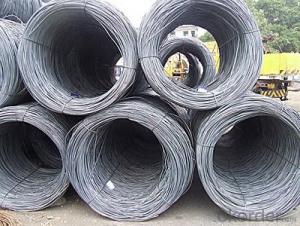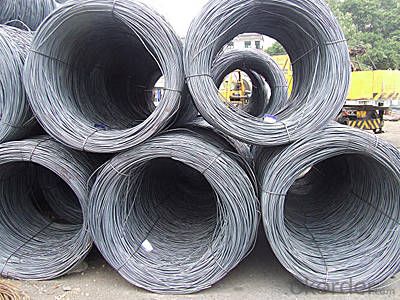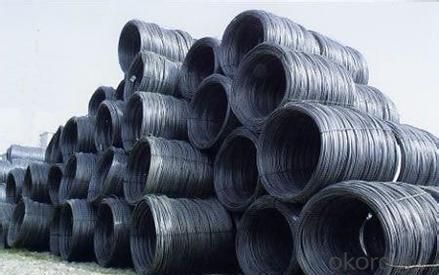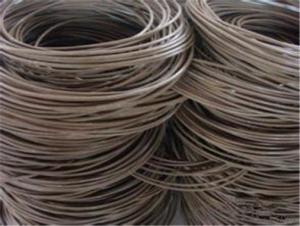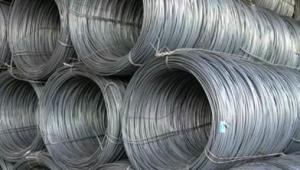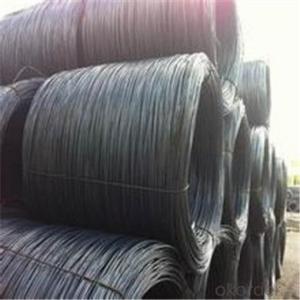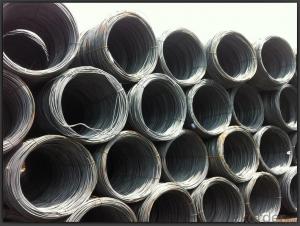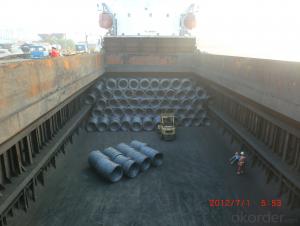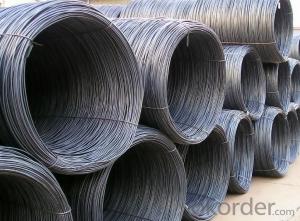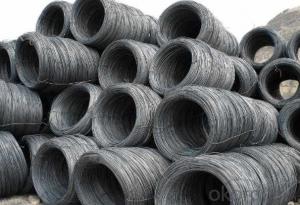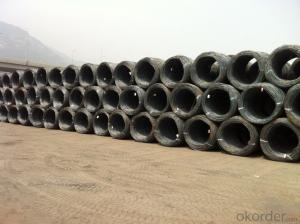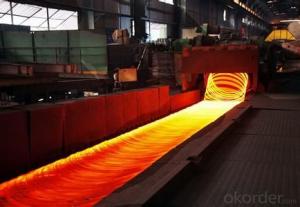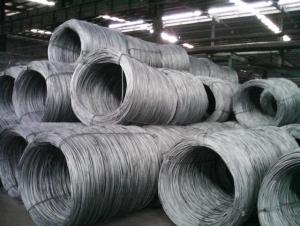Hot Rolled Steel Wire Rod with Good Quality with The Size 6.5mm
- Loading Port:
- Tianjin
- Payment Terms:
- TT OR LC
- Min Order Qty:
- 50 m.t.
- Supply Capability:
- 20000 m.t./month
OKorder Service Pledge
OKorder Financial Service
You Might Also Like
Hot Rolled Steel Wire Rod with Good Quality with The Size 6.5mm
Application: Carbon steel wire rod is widely used in construction and manufacturing. Carbon steel wire rod is mainly used for reinforcement of reinforced concrete and welded structure or reprocessed (roberts , nail, etc.) materials, especially used to produce wire drawing, welding electrode, nails, spring, electronic, precise machinery parts and so on.
Features:
Different Sizes: 5.5mm---16mm
Different Material Grade:SAE1006 SAE1008 SAE1010 SAE1012 etc
Packaging & Delivery of Wire Rod SAE1008B:
Packaging Detail: products are packed in coil and then shipped by container or bulk vessel
Each coil weight: 2-3MT
Delivery Detail: within 45 days after received deposit or LC.
Label: to be specified by customer, generally, each bundle has 1-2 labels

- Q: What are the different types of steel wire rod testing equipment?
- To ensure the quality and performance of steel wire rods, various types of testing equipment are utilized. Included among these are: 1. Tensile testing machines, which measure the maximum force a wire rod can endure by subjecting it to a pulling force until it breaks. 2. Hardness testers, which evaluate the hardness of the steel wire rod, a crucial determinant of its strength and durability. Different methods, such as Rockwell, Brinell, and Vickers hardness tests, are employed. 3. Ultrasonic testing equipment, a non-destructive method that utilizes high-frequency sound waves to identify internal defects and flaws within the wire rods. 4. Dimensional measurement tools, including micrometers, calipers, and gauges, that accurately measure the dimensions and tolerances of the wire rods. 5. Surface inspection equipment, which visually examines the wire rod's surface for any defects, such as cracks or irregularities. This can be done manually or with the aid of automated systems utilizing cameras and computer algorithms. 6. Chemical composition analyzers, which determine the presence and concentration of various elements in the wire rods, ensuring they meet the required composition standards. These examples represent just a portion of the testing equipment employed for steel wire rods. Each type plays a vital role in guaranteeing the quality, strength, and performance of these materials across diverse industries, including construction, automotive, and manufacturing.
- Q: What are the main factors driving the demand for steel wire rod?
- The main factors driving the demand for steel wire rod include the growth of various industries such as construction, automotive, and manufacturing, as well as the increasing demand for infrastructure development. Additionally, the rise in urbanization, population growth, and technological advancements also play a significant role in driving the demand for steel wire rod.
- Q: What are the standard tensile strength requirements for steel wire rod?
- The standard tensile strength requirements for steel wire rod depend on various factors such as the specific application, industry standards, and regulatory requirements. However, in general, steel wire rod typically has a minimum tensile strength of 500 megapascals (MPa) or 72,500 pounds per square inch (psi). This ensures that the wire rod is strong enough to withstand the expected mechanical stress and loading conditions it will encounter during its intended use. It is important to note that the tensile strength requirements can vary depending on the type of steel, the manufacturing process, and the desired properties of the final product. Therefore, it is crucial to consult the relevant industry standards or specifications to determine the precise tensile strength requirements for a specific application.
- Q: What are the advantages of using alloyed steel wire rod?
- There are several advantages of using alloyed steel wire rod. Firstly, alloying steel wire rod enhances its strength and hardness, making it more durable and resistant to wear and tear. This makes it suitable for demanding applications, such as in construction and automotive industries. Additionally, alloyed steel wire rod offers improved corrosion resistance compared to non-alloyed steel, making it ideal for outdoor or marine environments. Moreover, alloying steel wire rod allows for better machinability and weldability, enabling easier fabrication and customization. Finally, alloyed steel wire rod exhibits superior thermal and electrical conductivity, making it suitable for various electrical and electronic applications.
- Q: How is steel wire rod used in the manufacturing of wire forms for agricultural fencing?
- Steel wire rod is used in the manufacturing of wire forms for agricultural fencing by being transformed into various wire shapes and gauges. It can be straightened, cut, and then either woven or welded into the desired fence forms. The high tensile strength of steel wire rod provides durability and resistance, making it suitable for withstanding the pressure and impact that agricultural fencing may encounter.
- Q: Can steel wire rod be recycled?
- Yes, steel wire rod can be recycled. Steel is a highly recyclable material that can be melted down and reused to create new products. Recycling steel wire rods helps conserve natural resources and reduce waste.
- Q: What is the difference between a wire rod and a straight bar?
- Straight line refers to the production, delivery is a bundle of straight material delivery in winter, used for the diameter of coarse steel bar, general specifications of 9 meters and 12 meters, the dosage is large (1000 tons or more), steel mills will consider the order made
- Q: How is steel wire rod used in the manufacturing of wire for medical implants?
- Steel wire rod is an essential raw material used in the manufacturing of wire for medical implants. It serves as the base material from which the wire is produced. Steel wire rod is carefully selected for its high strength, corrosion resistance, and biocompatibility properties. It undergoes a series of processes including drawing, annealing, and surface treatments to transform it into fine wire suitable for medical applications. This wire is then utilized in the fabrication of various medical implants such as surgical sutures, stents, orthopedic devices, and pacemaker leads, providing strength, flexibility, and durability to these life-saving medical products.
- Q: What are the different sizes and dimensions of steel wire rod?
- Steel wire rods are available in a variety of sizes and dimensions to accommodate different industrial and commercial uses. The intended use and manufacturing standards typically determine the sizes and dimensions of steel wire rods. The diameter of steel wire rods can vary from as small as 0.1 millimeters (mm) to as large as 60 mm or more. Generally, the most common sizes in the market range between 5 mm and 20 mm in diameter. However, specialized applications may necessitate wire rods with larger or smaller diameters. The length of steel wire rods can vary significantly depending on the requirements. They are often produced in coils, which can range in length from a few meters to several kilometers. The length of wire rods can be customized to meet the customer's needs or industry standards. Regarding dimensions, steel wire rods are typically manufactured in a round shape. However, they can also be produced in other shapes such as square, rectangular, or hexagonal, depending on the specific application. The most prevalent shape is round because it provides excellent strength and flexibility for various uses. Furthermore, the weight of steel wire rods can vary based on the diameter and length. Usually, the weight is measured in kilograms (kg) or pounds (lb). The weight per unit length is determined by the specific gravity of the steel and the diameter of the wire rod. In conclusion, the sizes and dimensions of steel wire rods are extensive and can be customized to meet specific requirements. Whether it is for construction, automotive, or other industries, steel wire rods are available in a wide range of sizes to accommodate various applications.
- Q: What are the different types of steel wire rod surface cleaning equipment?
- There are several different types of steel wire rod surface cleaning equipment available in the market today. These include: 1. Shot blasting machines: Shot blasting is a popular method used to clean the surface of steel wire rods. It involves propelling small steel balls or beads at high speed onto the surface, which removes any dirt, rust, or scale. Shot blasting machines can be either airless or air-powered, and they are available in various sizes and capacities. 2. Wire brushing machines: Wire brushing machines use rotating brushes to clean the surface of steel wire rods. These brushes are made of stiff bristles, and they effectively remove dirt, rust, and scale from the surface. Wire brushing machines are available in different configurations, including hand-held tools and automated systems. 3. Ultrasonic cleaning machines: Ultrasonic cleaning is a non-abrasive method that uses high-frequency sound waves to remove contaminants from the surface of steel wire rods. The cleaning process involves immersing the rods in a tank filled with a cleaning solution, and then subjecting them to ultrasonic vibrations. This method is particularly effective in removing oil, grease, and other stubborn contaminants. 4. Chemical cleaning equipment: Chemical cleaning equipment utilizes various cleaning solutions or acids to remove dirt, rust, and scale from the surface of steel wire rods. The rods are usually dipped or sprayed with the cleaning solution, and then rinsed off with water. Chemical cleaning equipment can be manual or automated, depending on the scale of the operation. 5. Mechanical descaling machines: Mechanical descaling machines are specifically designed to remove scale from the surface of steel wire rods. These machines use rotating brushes, rollers, or abrasive belts to scrape off the scale. Mechanical descaling machines are often used in conjunction with other surface cleaning methods to achieve the desired level of cleanliness. Overall, the choice of steel wire rod surface cleaning equipment depends on factors such as the level of contamination, the desired cleanliness, and the production capacity. Each type of equipment has its own advantages and limitations, and it is crucial to select the most suitable one for the specific cleaning requirements.
Send your message to us
Hot Rolled Steel Wire Rod with Good Quality with The Size 6.5mm
- Loading Port:
- Tianjin
- Payment Terms:
- TT OR LC
- Min Order Qty:
- 50 m.t.
- Supply Capability:
- 20000 m.t./month
OKorder Service Pledge
OKorder Financial Service
Similar products
Hot products
Hot Searches
Related keywords
